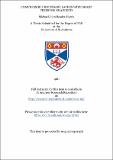Files in this item
Compressible boundary layers with sharp pressure gradients
Item metadata
| dc.contributor.advisor | Curle, S. N. | |
| dc.contributor.author | Reader-Harris, Michael John | |
| dc.coverage.spatial | 145 p. | en_US |
| dc.date.accessioned | 2018-06-07T09:45:24Z | |
| dc.date.available | 2018-06-07T09:45:24Z | |
| dc.date.issued | 1981 | |
| dc.identifier.uri | https://hdl.handle.net/10023/13795 | |
| dc.description.abstract | The work of this thesis was undertaken as a C.A.S.E. award project in collaboration with Rolls-Royce to examine compressible laminar boundary layers with sharp adverse pressure-gradients. Much of the work is devoted to the solution of two important particular problems. The first flow considered is that along a semi-infinite flat plate with uniform pressure when X < X₀ and with the pressure for X > X₀ being so chosen that the boundary layer is just on the point of separation for all X > X₀. Immediately downstream of X₀ there is a sharp pressure rise to which the flow reacts mainly in a thin inner sublayer; so inner and outer asymptotic expansions are derived and matched for the stream function and a function of the temperature. Throughout the thesis the ratio of the viscosity to the absolute temperature is taken to be a function of x, the distance along the wall, alone, and the Illingworth-Stewartson transformation is applied. The Prandtl number, σ, is taken to be of order unity and detailed results are presented for σ= 1 and 0.72. The second flow considered is that along a finite flat plate where the transformed external velocity U₁(X) is chosen such that U₁(X) = u₀(-X/L)[super]ε, where O< ε <<1, is the transformed length of the plate and X represents transformed distance downstream from the trailing edge. The skin friction, position of separation and heat transfer right up to separation are determined. On the basis of these two solutions, another solution which is not presented in detail, and a solution (due to Curie) to a fourth sharp pressure gradient problem, a general Stratford-type method for computing compressible boundary layers is derived, which may be used to predict the position of separation, skin friction, heat transfer, displacement and momentum thicknesses for a compressible boundary layer with an unfavourable pressure gradient. In all this work techniques of series analysis are used to good effect. This led us to look at another boundary-layer problem in which such techniques could be used, one in which two parallel infinite disks are initially rotating with angular velocity Ω about a common axis in incompressible fluid, the appropriate Reynolds number being very large. Suddenly the angular velocity of one of the disks is reversed. A new examination of this problem is presented in the appendix to the thesis. | en_US |
| dc.language.iso | en | en_US |
| dc.publisher | University of St Andrews | en |
| dc.subject.lcc | QA379.R3H2 | |
| dc.subject.lcsh | Boundary value problems | en |
| dc.title | Compressible boundary layers with sharp pressure gradients | en_US |
| dc.type | Thesis | en_US |
| dc.contributor.sponsor | Science Research Council (Great Britain) | en_US |
| dc.contributor.sponsor | Rolls-Royce Ltd. | en_US |
| dc.type.qualificationlevel | Doctoral | en_US |
| dc.type.qualificationname | PhD Doctor of Philosophy | en_US |
| dc.publisher.institution | The University of St Andrews | en_US |
This item appears in the following Collection(s)
Items in the St Andrews Research Repository are protected by copyright, with all rights reserved, unless otherwise indicated.

